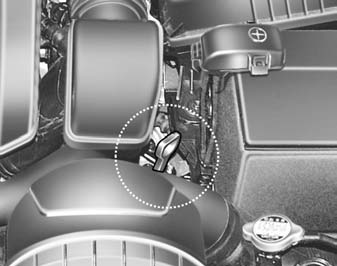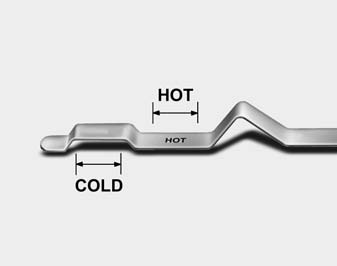Automatic transaxle fluid

Checking the automatic transaxle fluid level
The automatic transaxle fluid level should be checked regularly.
Keep the vehicle on the level ground with the parking brake applied and check the fluid level according to the following procedure.
1. Place the shift lever in N (Neutral) position and confirm the engine is running at normal idle speed.
2. After the transaxle is warmed up sufficiently (fluid temperature 70~80°C (158~176°F), for example by 10 minutes usual driving, move the shift lever through all positions then place the shift lever in “N (Neutral) or P (Park)” position.

3. Confirm that the fluid level is in “HOT” range on the level gauge. If the fluid level is lower, add the specified fluid from the fill hole. If the fluid level is higher, drain the fluid from the drain hole.
4. If the fluid level is checked in cold condition (fluid temperature 20~30°C (68~86°F) add the fluid to “C” (COLD) line and then recheck the fluid level according to the above step 2.
WARNING:
- Transaxle fluid.
The transaxle fluid level should be checked when the engine is at normal operating temperature. This means that the engine, radiator, radiator hose and exhaust system etc., are very hot. Exercise great care not to burn yourself during this procedure.
CAUTION:
• Low fluid level causes transaxle
slippage. Overfilling can cause
foaming, loss of fluid and transaxle
malfunction.
• The use of a non-specified fluid could result in transaxle malfunction and failure.
WARNING:
- Parking brake.
To avoid sudden movement of the vehicle, apply parking brake and depress the brake pedal before moving the shift lever.
NOTICE:
“C” (COLD) range is for reference only
and should NOT be used to determine
transaxle fluid level.
NOTICE:
New automatic transaxle fluid should be
red. The red dye is added so the assembly
plant can identify it as automatic
transaxle fluid and distinguish it from
engine oil or antifreeze. The red dye,
which is not an indicator of fluid quality,
is not permanent. As the vehicle is
driven, the automatic transaxle fluid
will begin to look darker. The color may
eventually appear light brown.
Therefore, have an authorized KIA dealer change the automatic transaxle fluid according to the Scheduled Maintenance at the beginning of this section.
Use only the specified automatic transaxle fluid. (Refer to “Recommended lubricants and capacities” in section 8.)
Changing the automatic transaxle fluid
Have automatic transaxle fluid changed by an authorized KIA dealer according to the Maintenance Schedule at the beginning of this section.
See also:
Drivetrain
The typical sedan has a larger engine than the Kia Rio. Keep in mind that
smaller engines are often cheaper to fix, but smaller engines can be stressed
more. The Kia Rio could learn a lesson or tw ...
Recommended lubricants and capacities
To help achieve proper engine and powertrain performance and durability, use
only lubricants of the proper quality. The correct
lubricants also help promote engine efficiency that results in improv ...
Child restraint system
Children riding in the car should sit in the
rear seat and must always be properly
restrained to minimize the risk of injury in
an accident, sudden stop or sudden
maneuver. According to accident s ...


